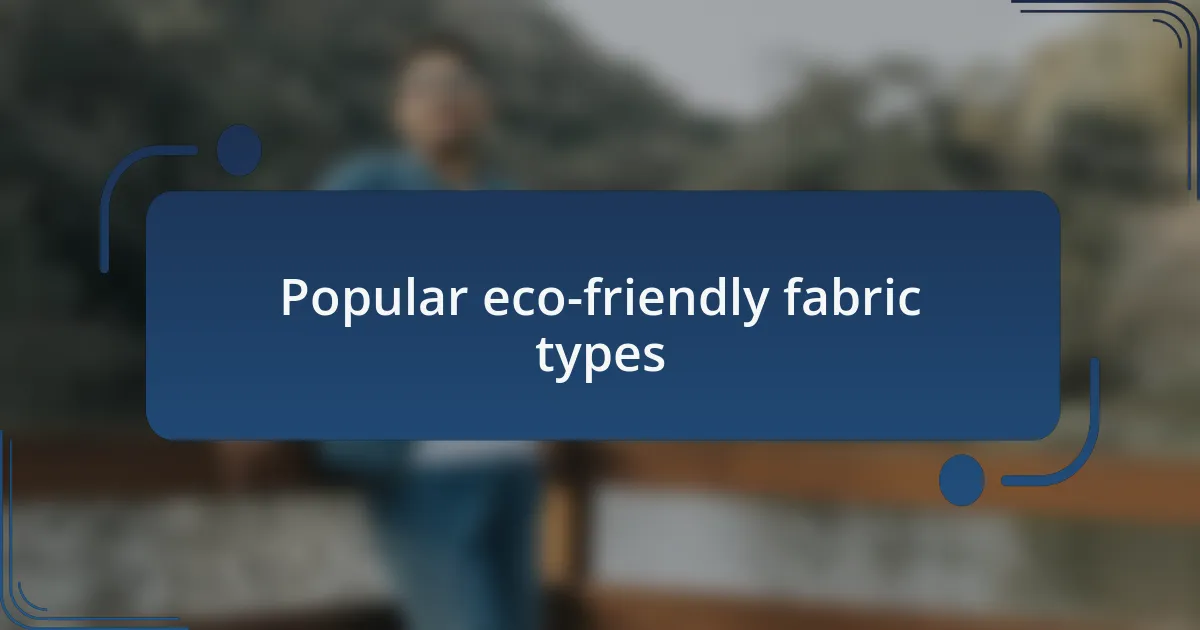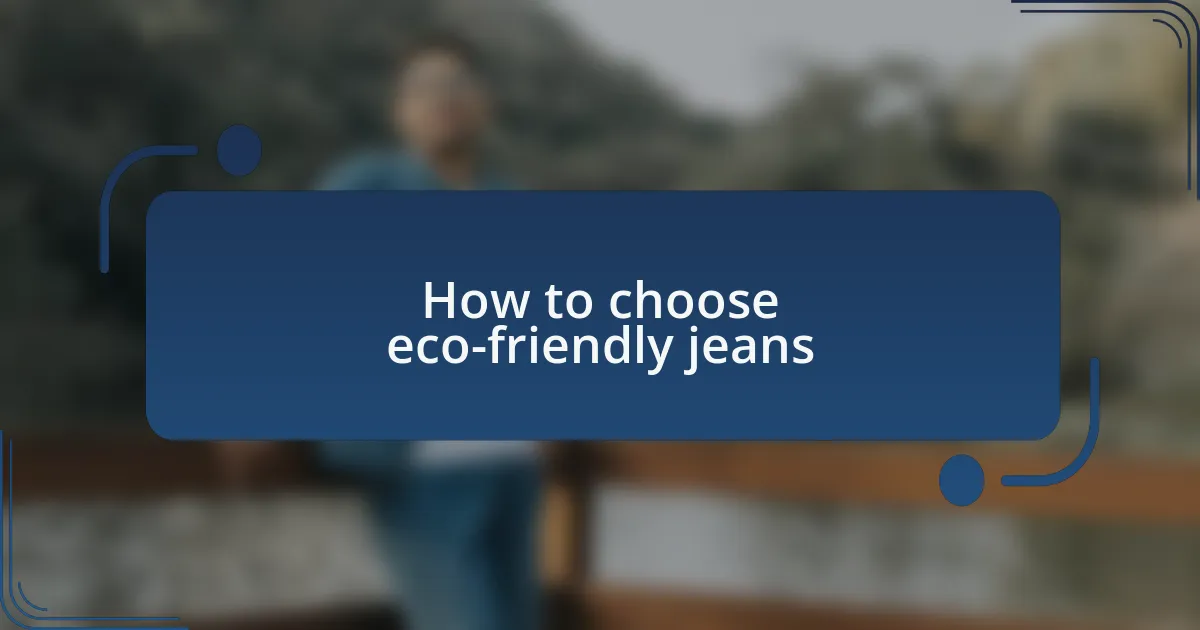Key takeaways:
- Eco-friendly fabrics are made from organic or recycled materials, reducing environmental impact and promoting sustainability.
- Popular fabrics include organic cotton, Tencel, and recycled denim, each offering comfort, breathability, and unique stories in their production.
- Choosing eco-friendly jeans involves looking for sustainable materials, low-impact manufacturing processes, and brands committed to ethical practices.
- Brands like Levi’s, Nudie Jeans, and Patagonia exemplify sustainable fashion through innovative practices, transparency, and community engagement.

What are eco-friendly fabrics
Eco-friendly fabrics are materials designed to minimize environmental impact throughout their lifecycle. They are typically made from organic or recycled materials, which means they reduce waste and avoid harmful chemicals. When I first discovered organic cotton, it felt like a revelation—how something so simple could be grown without pesticides and still deliver a comfortable feel.
These fabrics often have a lower carbon footprint, which is becoming increasingly important as we face climate change. For instance, Tencel, derived from eucalyptus trees, not only uses less water but also boasts a closed-loop production process that recycles wastewater. Have you ever thought about what happens during fabric production? I find it fascinating to consider how our clothing choices can contribute to a healthier planet.
Moreover, eco-friendly fabrics can be just as stylish and durable as traditional options. I remember swapping out my regular denim for a pair made from recycled materials, and I was pleasantly surprised by the quality. Isn’t it great to know that fashion can be both conscious and chic? By choosing sustainable options, we not only enhance our wardrobes but also make a statement about our values.

Benefits of eco-friendly fabrics
The benefits of eco-friendly fabrics extend beyond just being kind to the planet; they can also enhance our overall well-being. When I transitioned to wearing organic cotton tees, I noticed how much softer and breathable they felt against my skin. Isn’t it amazing how choosing sustainable options can elevate our comfort, making us feel good inside and out?
Another significant advantage is their potential for durability. I once invested in a pair of jeans made from recycled polyester, and they’ve held up against countless washes without losing their shape or color. This experience taught me that buying eco-friendly doesn’t mean sacrificing quality—in fact, it often means the opposite. How often do we overlook the longevity of our clothing in favor of cheaper, fast-fashion items?
Furthermore, eco-friendly fabrics often support ethical practices in the fashion industry. When I learned that some brands prioritize fair labor practices alongside sustainable sourcing, it made me feel more connected to the products I was purchasing. Isn’t it empowering to know that our fashion choices can contribute to a more just world? Sustainable fabrics not only appeal to my sense of style but also align with my values, creating a more mindful shopping experience.

Popular eco-friendly fabric types
Organic cotton is one of the most popular eco-friendly fabrics today. I remember the first time I tried on a pair of jeans made from organic cotton; they wrapped around me like a gentle hug. It was a subtle but profound reminder of how natural fibers can feel. Have you ever thought about how much better our skin feels with fewer chemicals?
Another fabric I’m passionate about is Tencel, which is derived from sustainably sourced wood pulp, usually from eucalyptus trees. When I discovered Tencel, I was blown away by its silky texture and breathability. It’s perfect for warmer weather, and the fact that it’s biodegradable makes me feel like I’m making a positive impact every time I wear it. Isn’t it great that something so luxurious can also be eco-conscious?
Lastly, there’s recycled denim, a game changer for reducing waste in the fashion industry. I once saw a brand that transformed old jeans into new garments and was fascinated by the creative potential of repurposing materials. This not only conserves resources but also tells a unique story with every piece—like wearing a part of the past while stepping into the future. How often do we consider the journey our clothes have taken before they get to us?

How to choose eco-friendly jeans
When choosing eco-friendly jeans, it’s essential to look for sustainable materials. For example, I remember perusing a local thrift shop and stumbling upon a pair of jeans made from hemp. The durability surprised me, and I felt a sense of accomplishment knowing that I was supporting a more sustainable fashion choice. Have you ever tried on a fabric that made you feel good about your impact on the planet?
Another crucial factor is the manufacturing process. I once researched a brand that prioritized low water usage and non-toxic dyes. They not only reduced their environmental footprint but also crafted jeans that felt more authentic and vibrant. Reflecting on that experience, I realized how our purchasing decisions can encourage companies to adopt greener practices. What kind of impact do your choices have?
Lastly, pay attention to the brand’s overall commitment to sustainability. It was eye-opening for me to find a company that not only produced eco-friendly jeans but also actively participated in community clean-ups and education on sustainable fashion. Their philosophy lingered with me long after my purchase, making that single pair of jeans feel like a part of a larger movement. When you wear your jeans, do you consider the values behind them?

My favorite eco-friendly jeans brands
One of my favorite eco-friendly jeans brands has to be Levi’s. They’ve made a remarkable shift towards sustainability with their Water Another brand that impresses me is Nudie Jeans, known for their commitment to organic cotton and fair production practices. I recently purchased a pair from them and was touched by their transparent approach—every detail, from sourcing to stitching, was shared openly. It made me reflect on how transparency in fashion can foster trust. How important is it for you to know where and how your clothes are made? Lastly, I can’t help but admire Patagonia. Not only do they craft durable jeans made from recycled materials, but their dedication to environmental activism truly resonated with me. I was moved by their mission, especially when I discovered that they invest a portion of their profits into environmental causes. It made me think about the effect of my purchases on the larger community. Do you ever consider how a brand’s values align with your own when shopping?

Why I love these brands
When it comes to why I love these brands, it truly boils down to their authentic commitment to sustainability. I have worn jeans from Levi’s that not only fitted beautifully but also made me feel like I was playing a part in something bigger. There’s a certain thrill in knowing that my choice is fostering more responsible practices in the fashion industry—how often can we say that about our clothes?
Nudie Jeans strikes a chord with me, mainly because their focus on organic cotton really speaks to my values. After learning about their recycling program, I decided to send in an old pair of my jeans, receiving a discount on my next purchase while contributing to a circle of sustainability. It’s fascinating to think that one small action can connect us to a larger movement; doesn’t that sound empowering?
Then there’s Patagonia, whose ethos of environmental activism has transformed how I view clothing brands. I remember attending a local cleanup event they sponsored, and seeing the brand’s name associated with such positive community engagement left a lasting impression on me. It made me ponder—how often do we get the chance to support a brand that’s actively working to protect the planet? Moments like these remind me that clothing can be more than just fabric; it can embody our values and inspire change.